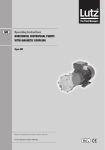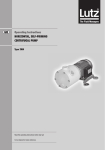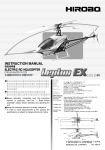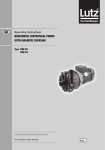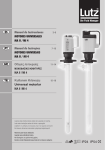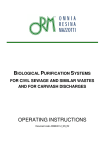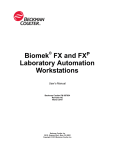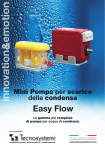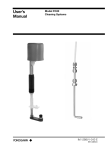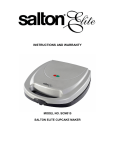Download Operating Instructions HOrIzOntal CentrIfuGal PumPs wItH
Transcript
GB GB Operating Instructions Horizontal Centrifugal Pumps with magnetic coupling Type TMB Read this operating instructions before start up! To be retained for future reference. GB Table of Contents 1. Safety risks........................................................................................................4 1.1 Installation and commissioning personnel..................................................5 1.2 Operators and maintenance personnel........................................................5 1.3 Repair personnel.........................................................................................5 1.4 Waste disposal............................................................................................5 1.5 Improper use..............................................................................................6 2. Identification codes............................................................................................6 3. General notes.....................................................................................................7 4. Operating principle.............................................................................................8 5. Motor.................................................................................................................9 6. Dry running survey............................................................................................9 7. Instructions on installation and use.................................................................10 7.1 Installation........................................................................................... 10/11 7.2 Start-up.....................................................................................................12 7.3 Use...........................................................................................................12 7.4 Shutdown.................................................................................................12 8. Maintenance......................................................................................................13 8.1 Dismantling...............................................................................................13 8.2 Inspection.................................................................................................13 9. Repairs..............................................................................................................14 10. Recommendation............................................................................................14 11. Operating faults and possible causes..............................................................15 12. Technical data.................................................................................................16 13. Dimensions.....................................................................................................17 Declaration of Conformity.....................................................................................19 GB 1. Safety risks Warning! Magnetic fields Magnetic pumps contain some of the most powerful magnets in existence. The magnets are positioned on the back of the impeller and the outer magnet housing. The magnetic fields may adversely affect persons fitted with electronic devices (e.g. pacemakers and defibrillators): such persons must not be allowed to handle magnetic pumps and magnetic pump components. Warning! Magnetic force Exercise extreme caution and follow instructions carefully during pump assembly/dismantling. Magnetic force attract (cause insertion of) internal and magnetic units, and are therefore a potential source of injury to fingers and hands. Warning! Chemical hazard! The pumps are designed to pump different types of liquid and chemical. Follow the specific instructions to decontaminate during inspection or maintenance. Warning! Safety risks for personnel mainly arise from improper use or accidental damages. These risks may be of an electrical nature as far as the non-synchronous motor is concerned and may cause injury to hands if working on an open pump. Risks may also arise due to the nature of the liquids pumped. It is therefore of utmost importance to closely follow all the instructions contained in this manual so as to eliminate the causes that may lead to pump failure and the consequent leakage of liquid dangerous for both personnel and the environment. Risks may also arise from improper maintenance or dismantling practices. In any case five general rules are important: A)all services must be carried out by specialised personnel or supervised by qualified personnel depending on the type of maintenance required B)install protection guards against eventual liquid sprays (when the pump is not installed in remote areas) due to an accidental pipe rupture. Arrange for safety basins to collect possible leakage. C)when working on the pump always wear acid-proof protective clothing D)arrange for proper conditions for suction and discharge valve closing during disassembly E)make sure that the motor is completely disconnected during disassembly Proper design and building of the plants, with well positioned and well marked piping fitted with shut-off valves, adequate passages and work areas for maintenance and inspections are extremely important (since the pressure developed by the pump could give some kind of damage to the plant in case this one should be faulty made or wear and tear-damaged). It must be stressed that the major cause of pump failures leading to a consequent need to intervene is due to the pump running dry in manually operated plants. This is generally due to: - the suction valve being closed at start-up or - the suction tank being emptied without stopping GB 1.1 Installation and commissioning personnel Interventions allowed only to specialised personnel who may eventually delegate to others some operations depending on specific evaluations (technical capability required: 1.2 Operators and maintenance personnel Interventions allowed to general operators (after training on the correct use of the plant): • pump starting and stopping • opening and closing of valves with the pump at rest • emptying and washing of the pump body via special valves and piping • cleaning of filtering elements Interventions by qualified personnel (technical capacities required: general knowledge of the mechanical, electrical and chemical features of the plant being fed by the pump and of the pump itself): • verification of environmental conditions • verification of the condition of the liquid being pumped • inspections of the control/stop devices of the pump • inspections of the rotating parts of the pump • trouble shooting 1.3 Repair personnel Interventions allowed to general operators under the supervision of qualified personnel: • stopping of the pump • closing of the valve • emptying of pump body • disconnection of piping from fittings • removal of anchoring bolts • washing with water or suitable solvent as needed • transport (after removal of electrical connections by qualified personnel) Interventions by qualified personnel (technical capacities required: general knowledge of machining operations, awareness of possible damage to parts due to abrasion or shocks during handling, know-how of required bolt and screw tightening required on different materials such as plastics and metals, use of precision measuring instruments): • opening and closing of the pump body • removal and replacement of rotating parts 1.4 Waste disposal Materials: separate plastic from metal parts. Dispose of by authorized companies. GB 1.5 Improper use The pump must not be used for purposes other than the transfer of liquids. The pump cannot be used to generate isostatic or counter pressures. The pump cannot be used to mix liquids generating an exothermal reaction. The pump must be installed horizontally on a firm base. The pump must be installed on a suitable hydraulic plant with inlet and outlet connections to proper suction and discharge pipes. The plant must be able to shut off the liquid flow independently from the pump. Handling of aggressive liquids requires specific technical knowledge. 2. Identification codes Each pump is supplied with range and model description on the rating plate which is placed on the support side. Check these data upon receiving the goods. Any discrepancy between the order and the delivery must be communicated immediately. Serial number Model Type GB 3. General notes “TMB” pumps are designed and built for the transfer of liquid chemical products having a specific weight, viscosity, temperature and stability of state appropriate for use with centrifugal pumps in a fixed installation, from a tank at a lower level to a tank or a pipe to a higher level. The characteristics of the liquid (pressure, temperature, chemical reactivity, specific weight, viscosity, vapour tension) and the ambient atmosphere must be compatible with the characteristics of the pump and are defined upon ordering. The max. pump’s performances (capacity, head, rpm) are defined on the identification plate. „TMB“ pumps are centrifugal, horizontal, single stage, coupled to a non-synchronous electric motor via a magnetic coupling, with axial inlet and radial outlet for connection to the hydraulic system. They are foot-mounted for floor fixing. “TMB” pumps are not self priming. The liquid to be pumped must be clean. Clockwise rotation seen from the motor side. Make sure that the chemical and physical characteristics of the liquid have been carefully evaluated for pump suitability. The admitted temperature of the liquid pumped is from 0 to 60°C. The max. viscosity is 20 mPas. The specific weight not above 1.1 kg/dm³ (at the max flow) The environment temperature between 0 and 45°C. The maximum pressure the pump may be subjected to is 1.5 times the head value developed with the outlet closed. The vapour pressure value of the liquid to be pumped must exceed (by at least 1m wc) the difference between the absolute total head (suction side pressure added to the positive suction head, or subtracted by the suction lift) and the pressure drops in the suction side piping (including the inlet NPSHr drops shown on the specific tables). The pump does not include any non return valve nor any liquid flow control or motor stop device. GB 4. Operating principle HYDRAULICALLY alike to all centrifugal pumps, it is equipped with a blade-type impeller rotating within a fixed housing. It has a tangential outlet (or radial with an internal deflector) and, by creating a depression in the center, it allows the liquid to flow from the central suction side. Then, flowing through the impeller’s blades, the fluid acquires energy and is conveyed towards the outlet. MECHANICALLY different from the traditional centrifugal pumps in the impeller motion drive thanks to the magnetic field created between the primary outer magnet and the inner magnet (not visible because housed inside the impeller hub). The magnetic field crosses the plastic parts and the liquid, and firmly couples the two magnet assemblies. When the motor causes the outer magnet to rotate together with its housing, the inner magnet assembly is dragged at the same speed. As a result the impeller, which is integral to it, is maintained in rotation. The SHAFT, totally within the housing, is not involved in the transmission of rotary motion; its only function is to act as a centering guide and support for the impeller. To this end the components are designed so that a spontaneous cooling circuit (due to a simple effect of pressure) is established to cool the surfaces subject to friction. Periodic inspections prevent the build-up of sediments between the shafts and the guide bushes significantly lengthening their working life. GB 5. Motor The protection level of TMB motors is IP 54. Protection level The initials IP are followed by two numbers: The first number indicates the level of protection against penetration of solid objects and in particular: 4 for solids whose dimension is greater than 1mm 5 for dust (eventual internal deposits will not harm operation) 6 for dust (no penetration) The second number indicates the protection against the penetration of liquids. In particular: 4 for water sprays from all directions 5 for jets of water from all directions 6 for tidal and sea waves According to the IP protection indicated on the identification plate of the motor and to the environmental conditions, arrange for opportune extra protections allowing in any case correct ventilation and rapid drainage of rainwater. 6. Dry running survey Though the pump can occasionally run dry for a short time, it is therefore suitable to safeguard the pump and the plant to use: • pressure switch; • flow meter; • control devices for the motor power absorption. GB 7. Instructions on installation and use 7.1 Installation • Clean the plant before connecting the pump. • Make sure that no foreign bodies are left in the pump. • Follow the instructions indicated in the following diagram: 1) YES: gate valve (may also be near pump in the case of long piping) 2) With positive head: tilt of piping towards pump. 3) Use a line strainer (3-5 mm mesh) against impurities. 4) NO: air pockets: the circuit must be short and straight. 5) YES: pipe fixing parts 6) Fluid speed suction: 2.5 m/s 7) YES: check value (especially for long vertical or horizontal pipes; compulsory with parallel pumps). 8) YES: adjusting gate valve on outlet. 9) Speed of delivered fluid: 3.5 m/s max. 10) YES: attachment for gauge or safety pressure switch 11) NO: elbow joints (and other parts) on the pump (discharge and suction lines) 12) With negative suction lift: tilt of piping towards suction tank. 13) YES: check valve (with negative suction lift) 14) Use a strainer (3-5 mm mesh) against impurities. 15) Suction head varies according to flow in order to prevent windage (min. 0.5 m, max. 15% of pump head). 16) Suction head, 3 m max. 17) Immersion depth, 0.3 m min. 18) YES: expansion joint (indispensable with long pipes or hot liquids) and/or anti-vibration facility during discharge and suction; anchored near to pump. 19) YES: pipe discharge (completely sealed), discharge value shut during normal operations 20) YES: overcoming obstacles at lower depths 21) Fix the pump by the fixing holes provided: the supports must be level 22) YES: drainage channel around base 10 GB • Anchor the pump to an adequate base plate having a mass at least 5 times that of the pump. • Do not use anti-vibration mounts to fix the pump. • Anti-vibration joints are recommended on the pipe connections. • Make sure that the power supply is compatible with the data shown on the pump motor identification plate. • Connect the motor to the power supply via a magnetic/thermal control switch. • Install emergency stop devices to switch off the pump in case of low liquid level (floating, magnetic, electronic, pressure- sensitive). • Ambient temperature as a function of the physical-chemical characteristics of the liquid to be pumped and in any case not greater or lower than the interval indicated in the field of application. • Other environmental conditions in accordance with the IP protection of the motor. • Install a drainage pit to collect any liquid overflow from the base drainage channel due to normal maintenance work. • Leave enough free space around the pump for a person to move. • Leave free space above the pump for lifting operations. • Highlight the presence of aggressive liquids with coloured tags following the local safety regulations. • Do not install the pump (made in thermoplastic material) in close proximity to heating apparatus. • Do not install the pump in areas subject to solid or liquid matter falling. • Do not install the pump in an explosive atmosphere. • Do not install the pump in close proximity to workplaces or crowded areas. • Install extra protection guards for the pump or persons as the need arises. • Install a spare equivalent pump in parallel. 11 GB 7.2 Start-up • Verify that the instructions outlined in the INSTALLATION have been followed. • Ensure that the NPSH available is greater than that required by the pump (in particular for hot liquids, liquids with high vapour pressure, very long suction pipes or negative suction lift). • Close the drain valve (pos. 19); totally flood the suction pipe and the pump. • Start the pump with the suction valve completely open and the discharge valve partially closed. • Slowly regulate the flow by opening or closing the discharge valve (never the suction valve). Make sure that the power absorbed by the motor does not exceed the rated one indicated on the motor identification plate. • Do not operate the pump at the limit values of its performance curve: maximum head (discharge valve excessively closed) or maximum capacity (total absence of drops and geodetic head on the discharge side). • Set the operating point to that for which the pump was requested. • Ensure that there are no abnormal vibrations or noise due to inadequate mounting or cavitation. • Avoid short and/or frequent starts by properly setting the control devices. • Ensure that the temperature, pressure and liquid characteristics are as those specified at the time of order. 7.3 Use • Switch automatic control on. • Do not activate valves whilst the pump is in operation. • Risks of dangerous water hammer effects in case of sudden or improper valve actuation (only trained personnel should operate valves). • Completely empty and wash the pump before using a different liquid. • Isolate or empty the pump if the crystallization temperature of the liquid is the same or lower than the ambient temperature. • Stop the pump if the liquid temperature exceeds the maximum allowed temperature indicated in the general notes; if the increase is of approximately 20%, check internal parts. • Close the valves in case of leaks. • Wash with water only if compatible from the chemical point of view. As alternative use an appropriate solvent that will not generate dangerous exothermal reactions. • Contact the liquid supplier for information on the appropriate fire precautions. • Empty the pump in case of long periods of inactivity (in particular with liquids which would easily crystallize). 7.4 Shutdown • Disconnect the motor • Before starting maintenance, turn off the suction and discharge valves 12 GB 8. Maintenance • All maintenance operations must be performed under the supervision of qualified personnel. • Make periodic inspections (2 to 30 days depending on the type of liquid and the operating conditions) of the in- line and foot filters as well as of the bottom valve. • Make periodic inspections (2 to 6 months depending on the type of liquid and the operating conditions) on the rotating parts of the pump; clean or replace or lubricate as necessary (see RECOMMENDATIONS). • Make periodic inspections (3 to 5 months depending on the type of liquid and the operating conditions) on the functionality of the motor control system; efficiency must be guaranteed. • The presence of liquid below the pump could be a clue to pump problems • Excessive current consumption could be an indication of impeller problems • Unusual vibrations could be due to unbalanced impeller (due to damage or presence of foreign material obstructing its blades). • Reduced pump performance could be due to an obstruction of the impeller or damages to the motor. • Motor damages could be due to abnormal friction within the pump. • Damaged parts must be replaced with new original parts. • The replacement of damaged parts must be carried out in a clean and dry area. 8.1 Disassembly • All maintenance operations must be performed under the supervision of qualified personnel. • Cut off the power supply from the motor and disconnect the electrical wiring; pull the wires out from the terminal box and isolate their extremities accordingly. • Close the suction and discharge valves and open the drain valve. • Use gloves, safety glasses and acid-proof overalls when disconnecting and washing the pump. • Disconnect the piping and leave enough time for the residual liquid to exit the pump body and atmospheric air to fill the empty volume. • Wash the pump before carrying out any maintenance work. • Do not scatter the liquid in the environment. • Before attempting to dismantle the pump ensure that its motor is disconnected and that it may not be started accidentallly. • Now open the pump following the sequence indicated in the respective table of the LEGEND. • For the disassembly of the rotating parts follow the suggestions outlined in the recommendations section. 8.2 Inspection Check: • the pump shaft for cracks and excessive wear • guide bushing for excessive wear(≅ 5 %) • counterthrust bushing for cracks or excessive wear • pump shaft clutch • the impeller, volute and rear chamber for abrasion and corrosion • for lumps and clusters created by the pumped liquid (especially at the bottom the rear chamber) • for infiltration of liquid into the chamber containing the inner magnets • abrasions on the outside surface of the rear chamber due to scratching of the outer magnets Replace broken, cracked or deformed parts. Reopen all the blocked pipes and eliminate any chemical agglomeration. Clean all the surfaces before re-assembly, especially the O-ring seats (risk of drip leaks). 13 GB 9. Repairs Before sending back the appliance, following must be observed: • Residuals in the appliance can cause danger to the environment and human health. The appliance must be completely emptied, rinsed and cleaned. • Please advise which liquid has been pumped. A respective safety data sheet must be attached to the return consignment. 10. Recommendations Disassembly: All threads are right handed. The impeller, once the pump body is open, is held in its seat only by a magnetic field. Take care it does not fall away whilst being pulled out axially (risk of damage to counterthrust ring or finger injury). Replace the parts which were: broken, cracked or smelt. Clean all surfaces before reassembly; in particular bushes, counterthrust rings (risk of premature wear) and o-ring seats (risk of leakage). Improper use: The pump must not be used for purposes other than the transfer of liquids. The pump cannot be used to generate isostatic or counter pressures. The pump cannot be used to mix liquids generating an exothermal reaction. The pump must be installed horizontally on a firm base. The pump must be installed on a suitable hydraulic plant with inlet and outlet connections to proper suction and discharge pipes. The plant must be able to shut off the liquid flow independently from the pump. Handling of aggressive liquids requires specific technical knowledge. 14 GB 11. Operating faults and possible causes Pump does not deliver: 1. rotates in wrong direction 2. suction pipe is excessively long and tortuous 3. insufficient geodetic pump head or excessive suction geodetic lift 4. air infiltration into the suction pipe or branches 5. pump or suction pipe not completely covered by liquid 6. impeller channels blocked by impurities 7. check valve on discharge pipe jammed 8. geodetic system height is greater than maximum potential pump head 9. impeller jammed by considerable layer of crystals or by melting of materials for dry rotation 10.bottom valve blocked by mud or other debris 11.bottom valve insufficiently immersed 12.bottom valve faulty, thereby causing suction valve to empty when pump stops 13.magnets release a much greater specific weight and flow rate of liquid than planned 14.magnets release during start-up while the impeller is moving anti-clockwise (feed-back of the liquid in the discharge side). Pump discharge rate or pressure insufficient: see 01, 02, 03, 04, 05, 06, 10, 11, 12, 13 15.system‘s resistance head is greater than expected 16.suction pipe, closing valve and other items have an insufficient nominal diameter 17.small geodetic pump suction head 18.damaged or worn impeller 19.liquid viscosity greater than expected 20.excessive quantities of air or gas in liquid 21.elbow joints, check valves or other items on the outlet port 22.liquid (especially if hot) with tendency to change into gaseous state Pump absorbs too much power: see 19 23.pump operates at greater capacity than expected 24.specific weight of liquid is greater than expected 25.impurities inside pump create abnormal wear 26.electric motor supply voltage is not rated voltage Pump vibrates and is noisy: see 25 27.operates at full capacity (no head) 28.pump or pipes inadequately fixed 29.eccentric impeller operation because of worn bushes Pump’s internal parts wear out too quickly: see 25 30.liquid excessively abrasive 31.recurring cavitation problems (see 02, 15, 19, 17) 32.high tendency of liquid to crystallise or polymerise when pump is not operating 33.pump made of materials that are unsuitable for pumped liquid 34.operation with capacity too reduced 15 GB 12. Technical data Pump Motor Connection TMB 16 Thread Hose 10 20 30 35 65 Ø Inlet BSP/ NPT - 3/4" 3/4" 1/2" 1" Ø Discharge BSP/ NPT - 3/4" 3/4" 3/8" 1" Ø Inlet mm 14 18 20 18 26 Ø Discharge mm 14 17 20 18 26 Power input (50/60 Hz ) W 25/21 29/39 57/73 57/73 97/134 Power output (50/60 Hz ) W 8/7 15/21 30/43 30/43 63/87 Phases N° Standard voltage V Max. head (50/60 Hz) m 1.8/2.2 3/4 3.4/4.5 8/11 6/8.2 Max. capacity (50/60 Hz) l/min 12/14 21/25 41/45 16/18 62/70 Noise dB 35 Weight kg 0,9 1 AC 220/240 - 50/60 Hz 40 2,2 3 45 3 5 GB 13. Dimensions TMB De M (BSP/NPT) De A (BSP/NPT) 10 20 30 35 65 - 3/4" AG 3/4" AG 3/8" AG 1" AG - 3/4" AG 3/4" AG 1/2" AG 1" AG Dp M 14 17 20 18 26 Dp A 14 18 20 18 26 a1 31 37 48 34 62 h1 45 55 60 60 67 h2 47 74 75 75 84 L 100 181 206 206 222 m1 16 30 40 40 40 M 30 50 64 64 68 n1 78 70 100 100 120 N 90 92 120 120 144 Q 17 30 32 40 45 r 46,5 75 94 94 115 R dxz 70 90 90 90 115 Ø5x4 Ø6x4 Ø8x4 Ø8x4 Ø8x4 17 GB 18 Lutz Pumpen GmbH Erlenstraße 5-7 D-97877 Wertheim Declaration of Conformity We herewith declare that the design and construction of the following machine in the versions marketed by us fully comply with the relevant basic safety and health requirements specified by the EC Directives listed. This declaration ceases to be valid if the machine is modified in any way without prior consultation with us. Type of device: Horizontal centrifugal pump with magnetic coupling Type: TMB EC Directives: EC-Directive 2006/42/EC, annex I, section 1 without 1.2; such machines do not include commands or start/stop controls EC-Directive on low voltage installations (2006/95/EC) EMV-Directive (2004/108/EC) Person authorised to compile the technical file: Mr. Klaus Saemann, Lutz Pumpen GmbH, Erlenstraße 5-7, D-97877 Wertheim Wertheim, 01.12.2009 Jürgen Lutz, Managing Director Lutz Pumpen GmbH Erlenstraße 5-7 D-97877 Wertheim Phone(93 42) 8 79-0 Fax (93 42) 87 94 04 e-mail: [email protected] http://www.lutz-pumpen.de Subject to technical changes. 04/10 Best.-Nr. 6999-701 Printed in Germany / Dru.




















